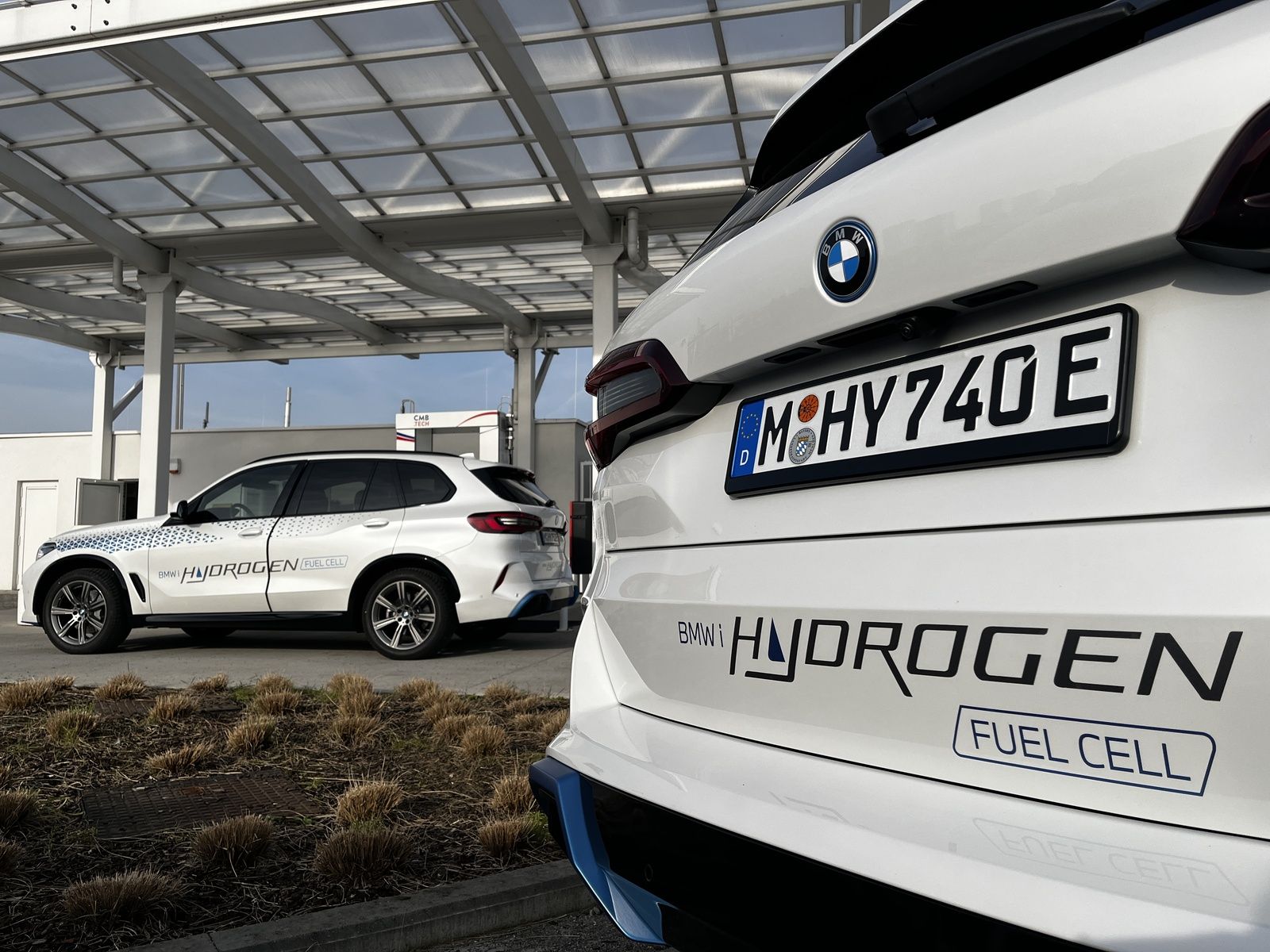We pilot the premium automaker’s hydrogen-driven test vehicles ahead of BMW’s plan to bring the alternative fuel to market

Article content
As the modern automotive market keeps plugging away toward electrification, BMW has recently signalled a lane-change—sort of. Maybe it’s more of a merge. See, battery-electric vehicles, or hybrids, or plug-in hybrids, are now featured by nearly all manufacturers as an alternative to their traditional fuel-driven internal-combustion-engine offerings.
Advertisement 2
Article content
The BMW Group, to name one example, sold more than 215,000 fully electric vehicles worldwide in 2022, a nearly 108-per-cent increase over 2021. That means the automaker’s EVs made up a touch less than nine per cent of total sales. In 2023, its full EVs are slated to charge ahead to 15 per cent of total sales, so there’s clearly an increased demand for alternative-fuel vehicles.
But battery-electric vehicles aren’t the only game in town. Pictured above are BMW’s second-generation hydrogen-powered test vehicles, follow-ups to the short-lived 2005 to 2007 Hydrogen 7 prototypes that used a “bivalent engine” powered by hydrogen and gasoline. BMW made just 100 of those.
This next round of hydrogen-driven vehicles represent the first step in something bigger. See, the premium brand has plans to introducing hydrogen fuel-cell vehicles into its product mix—hence my “merge” reference.
Advertisement 3
Article content
BMW been clocking kilometres on a small test fleet of iX5 Hydrogen vehicles, and in mid-February 2023, it invited global media representatives to experience the SUVs. Without reinventing the wheel, all BMW’s done is taken a gasoline X5 – made in Spartanburg, South Carolina – shipped it to Germany, then had it retrofitted with a new hydrogen powertrain.
So why hydrogen, and why now? I travelled to Antwerp, Belgium to both test-drive the iX5 and learn more about it; that mean, in part, sitting in on an in-person roundtable discussion with Oliver Zipse, Chairman of the Board and CEO of BMW.
Zipse explained that BMW’s drive into hydrogen fuel-cell vehicles was meant to augment its non-gasoline offerings—and, importantly, not to replace them. “There will be, in the next 20 to 30 years, a combination of [types of] emissions-free driving, a combination of dependable [EV] charging infrastructure and hydrogen infrastructure,” Zipse predicts. “If you try to run fast with one leg, that could be quite difficult. So we believe there is a ‘second leg.’”
Advertisement 4
Article content
-
Motor Mouth: The most important electric vehicle since the Tesla Model S?
-
Toyota reveals hydrogen-fueled and electric-powered AE86 Corolla Concepts
“The dominant ‘leg,’ don’t get us wrong, will always be battery-electric vehicles; it will always be the dominant leg. We’re not talking about the replacement of it,” he says.
If hydrogen seems like fantasy at the moment, consider how fast things have changed over the past 10 years, cautions the CEO. “When we started with our first [BMW-built] Mini [Cooper] E in 2008, absolutely no one even thought about driving an electric car,” says Zipse. “Seven years later, it was the coolest thing on Earth.”
“We believe, especially as a premium car brand, hydrogen is probably going to be the next coolest thing to drive. Of course, that happens after a 10- to 15-year delay; it’s not happening in the same year.”
Advertisement 5
Article content
Okay, but then, why now? “We think hydrogen is a missing link, which is not so obvious,” opines Zipse. “What you see today with the EV will scale up very quickly, with 40- to 60-per-cent market share in specific countries. But then, you will run into an equilibrium,” he says, a slow-down tempered by “a scarcity of raw materials, the pricing of raw materials, missing charging infrastructure,” around the year 2027 or 2028.
“That is where hydrogen comes in. It uses less raw materials; it’s a much, much smaller battery; the car is lighter; and it does not need the same charging infrastructure. You can more or less use the same infrastructure we use today at fuelling stations,” Zipse explains. “To put a hydrogen tank in, it’s much, much easier from the infrastructure side.”
Advertisement 6
Article content
If you noticed his multiple mentions of “infrastructure,” you’re not alone. That’s a crucial aspect to alternative fuels — where drivers can obtain them. In Canada, public charging stations for electric vehicles (well, consistently working ones, at least) lag far behind the number of electric vehicles on the road. While the majority of EV drivers have a Level 2 charger at home, not all do.
On the hydrogen side, BMW believes it’s easier to install a hydrogen charging station in an existing gas station than to completely create a from-scratch EV charging station. In terms of automotive manufacturing, BMW says fuel-cell vehicles need around 100 kg less raw materials than battery-electric vehicles, and also need 90 per cent less critical raw materials than battery-electric vehicles.
Advertisement 7
Article content
So we now know why BMW is adding hydrogen to the mix. But exactly how will these powertrains operate, and what will they feel like?
If you try to run fast with one leg, that could be quite difficult—so we believe there is a ‘second leg’
Oliver Zipse, BMW CEO
After spending a few hours driving in mostly urban settings – yet in both city and highway conditions – I have to say the iX5 was impressive. It uses fifth-generation BMW e-Drive technology (that means the electric motor, transmission, and power electronics, all grouped together in a compact housing) at the rear axle, and a battery with lithium-ion technology developed specially for this vehicle. Altogether, the powertrain produces a maximum output of 295 kW, or about 401 horsepower. The iX5’s two hydrogen tanks hold a combined six kilograms, and offer an WLTP-cycle range of 504 km. Consumption under WLTP is rated at 1.19 kg/100 km
Advertisement 8
Article content
Like in BMW’s all-electric iX and i4, acceleration is brisk and responsive, and, yes, there are regenerative paddle shifters with multiple levels of regen on the steering column. In summary, the powertrain feels like any modern electric vehicle’s, which is what BMW wants, as it values keeping its famed driving dynamics intact, regardless of the type of fuel propelling the vehicle. It’s labelled this drivetrain the “world’s most powerful passenger-vehicle fuel-cell system.”
How does it work? Beneath the iX5’s hood is a fuel-cell system, running at 125 kW. That’s connected to two hydrogen tanks – one along the centre of the vehicle, and the other beneath the rear seats – forming a “T” shape. Behind that, beneath the trunk, is a 295-kW electric motor; and above that is 170-kW power battery.
Advertisement 9
Article content
All these pieces work in conjunction, providing what BMW says is “all the advantages of electric driving,” but via hydrogen. The only thing coming out of the tailpipes are water-vapour exhaust, as is the case with all hydrogen vehicles.
Interestingly, the gasoline X5 and hydrogen iX5 have identical dimensions, including in terms of cargo space. That’s a massive cost savings for BMW, which doesn’t have to too heavily re-engineer the iX5. It’s also enticing for potential customers in terms of its just-like-gas functionality.
Will BMW’s move to make hydrogen its supplemental offering produce a high yield? Perhaps—it’s too early to say. It is, however, a forward-thinking approach, seeing as global mobility apparently cannot run on batteries alone. And with an advanced drivetrain, consumer familiarity with the basic vehicle and its specs, and an alternative to rechargeable battery technology, this very well could be something we see regularly on our roads by 2030.
“We should use this potential to also accelerate the transformation of the mobility sector,” if you ask Zipse. “Hydrogen is the missing piece in the jigsaw when it comes to emissions-free mobility. One technology on its own will not be enough to enable climate-neutral mobility worldwide.”
Stay connected with us on social media platform for instant update click here to join our Twitter, & Facebook
We are now on Telegram. Click here to join our channel (@TechiUpdate) and stay updated with the latest Technology headlines.
For all the latest Automobiles News Click Here


Comments
Postmedia is committed to maintaining a lively but civil forum for discussion and encourage all readers to share their views on our articles. Comments may take up to an hour for moderation before appearing on the site. We ask you to keep your comments relevant and respectful. We have enabled email notifications—you will now receive an email if you receive a reply to your comment, there is an update to a comment thread you follow or if a user you follow comments. Visit our Community Guidelines for more information and details on how to adjust your email settings.
Join the Conversation